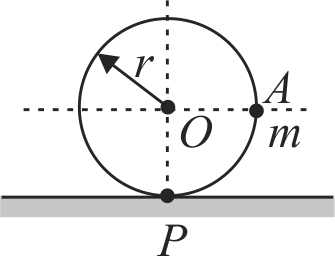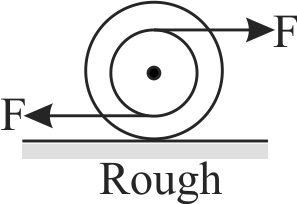365969 Two cylinders having radii \(2 \mathrm{R}\) and \(\mathrm{R}\) and moment of inertia \(4I\) and \(I\) about their central axes are supported by axles perpendicular to their planes. The large cylinder is initially rotating clockwise with angular velocity \(\omega_{0}\). The small cylinder is moved to the right until it touches the large cylinder and is caused to rotate by the frictional force between the two. Eventually slipping ceases and the two cylinders rotate at constant rates in opposite directions. During this
365970
A particle of mass ' \(m\) ' is rigidly attached at ' \(A\) ' to a ring of mass ' \(3 \mathrm{~m}\) ' and radius ' \(\mathrm{r}\) '. The system is released from rest and rolls without sliding. The angular acceleration of ring just after release is
365971
A disc is rolling without slipping on a surface. The radius of the disc is \(R\). At \(t=0\), the top most point on the disc is \(A\) as shown in figure. When the disc completes half of its rotation, the displacement of point \(A\) from its initial position is
365969 Two cylinders having radii \(2 \mathrm{R}\) and \(\mathrm{R}\) and moment of inertia \(4I\) and \(I\) about their central axes are supported by axles perpendicular to their planes. The large cylinder is initially rotating clockwise with angular velocity \(\omega_{0}\). The small cylinder is moved to the right until it touches the large cylinder and is caused to rotate by the frictional force between the two. Eventually slipping ceases and the two cylinders rotate at constant rates in opposite directions. During this
365970
A particle of mass ' \(m\) ' is rigidly attached at ' \(A\) ' to a ring of mass ' \(3 \mathrm{~m}\) ' and radius ' \(\mathrm{r}\) '. The system is released from rest and rolls without sliding. The angular acceleration of ring just after release is
365971
A disc is rolling without slipping on a surface. The radius of the disc is \(R\). At \(t=0\), the top most point on the disc is \(A\) as shown in figure. When the disc completes half of its rotation, the displacement of point \(A\) from its initial position is
365969 Two cylinders having radii \(2 \mathrm{R}\) and \(\mathrm{R}\) and moment of inertia \(4I\) and \(I\) about their central axes are supported by axles perpendicular to their planes. The large cylinder is initially rotating clockwise with angular velocity \(\omega_{0}\). The small cylinder is moved to the right until it touches the large cylinder and is caused to rotate by the frictional force between the two. Eventually slipping ceases and the two cylinders rotate at constant rates in opposite directions. During this
365970
A particle of mass ' \(m\) ' is rigidly attached at ' \(A\) ' to a ring of mass ' \(3 \mathrm{~m}\) ' and radius ' \(\mathrm{r}\) '. The system is released from rest and rolls without sliding. The angular acceleration of ring just after release is
365971
A disc is rolling without slipping on a surface. The radius of the disc is \(R\). At \(t=0\), the top most point on the disc is \(A\) as shown in figure. When the disc completes half of its rotation, the displacement of point \(A\) from its initial position is
365969 Two cylinders having radii \(2 \mathrm{R}\) and \(\mathrm{R}\) and moment of inertia \(4I\) and \(I\) about their central axes are supported by axles perpendicular to their planes. The large cylinder is initially rotating clockwise with angular velocity \(\omega_{0}\). The small cylinder is moved to the right until it touches the large cylinder and is caused to rotate by the frictional force between the two. Eventually slipping ceases and the two cylinders rotate at constant rates in opposite directions. During this
365970
A particle of mass ' \(m\) ' is rigidly attached at ' \(A\) ' to a ring of mass ' \(3 \mathrm{~m}\) ' and radius ' \(\mathrm{r}\) '. The system is released from rest and rolls without sliding. The angular acceleration of ring just after release is
365971
A disc is rolling without slipping on a surface. The radius of the disc is \(R\). At \(t=0\), the top most point on the disc is \(A\) as shown in figure. When the disc completes half of its rotation, the displacement of point \(A\) from its initial position is



